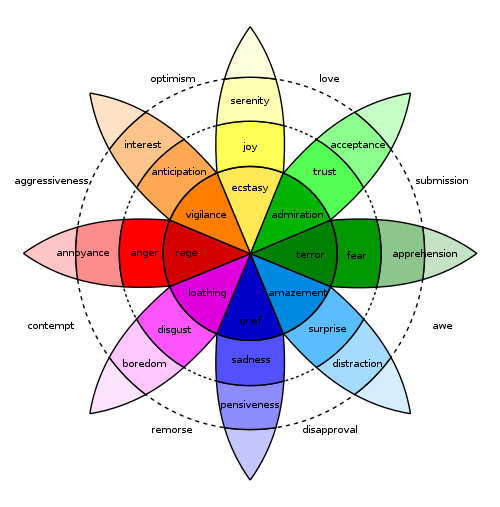Emotional detachment
In psychology, emotional detachment [1] is the inability to connect to others on an emotional level as well as a means of coping with anxiety by avoiding certain situations that trigger it.[2] It refers to the evasion of emotional connections. It may be a temporary reaction to highly emotional circumstances or a chronic condition such as a depersonalization disorder.
Signs and symptoms
Emotional detachment may not be as outwardly obvious as other psychiatric symptoms. People experiencing emotional detachment have a reduced ability to express emotion, to empathize with others or to form powerful emotional connections. They are also at an increased risk for many anxiety and stress disorders. This can lead to difficulties in creating and maintaining personal relationships. The person may move elsewhere in their mind and appear preoccupied or "not entirely present", or they may seem fully present but exhibit purely intellectual behavior when emotional behavior would be appropriate. They may have a hard time being a loving family member, or they may avoid activities, places, and people associated with past traumas. Their dissociation can lead to lack of attention and, hence, to memory problems and in extreme cases, amnesia. In some cases, they present an extreme difficulty in giving or receiving empathy which can be related to the spectrum of narcissistic personality disorder.[3]
Causes
Emotional detachment often arises due to psychological trauma in early years. For example, children who were raised in abusive or neglectful environments are more likely to experience emotional detachment as adults.[4] SSRI (selective serotonin reuptake inhibitor) antidepressants have also been known to cause "emotional blunting"[5] under certain circumstances (for example, if they are taken for extended periods of time or if a number of different SSRI antidepressants are taken one after another).
Behavioral mechanism
Emotional detachment can be a positive behavior which allows a person to react calmly to highly emotional circumstances. Emotional detachment in this sense is a decision to avoid engaging emotional connections, rather than an inability or difficulty in doing so, typically for personal, social, or other reasons. In this sense it can allow people to maintain boundaries, psychic integrity and avoid undesired impact by or upon others, related to emotional demands. As such it is a deliberate mental attitude which avoids engaging the emotions of others.
This detachment does not necessarily mean avoiding empathy; rather, it allows the person to achieve the space needed to rationally choose whether or not to be overwhelmed or manipulated by such feelings. Examples where this is used in a positive sense might include emotional boundary management, where a person avoids emotional levels of engagement related to people who are in some way emotionally overly demanding, such as difficult co-workers or relatives, or is adopted to aid the person in helping others such as a person who trains himself to ignore the "pleading" food requests of a dieting spouse, or indifference by parents towards a child's begging.
Emotional detachment can also be "emotional numbing", "emotional blunting", i.e., dissociation, depersonalization or in its chronic form depersonalization disorder. This type of emotional numbing or blunting is a disconnection from emotion, it is frequently used as a coping survival skill during traumatic childhood events such as abuse or severe neglect. Over time and with much use, this can become second nature when dealing with day to day stressors.
Emotional detachment may allow acts of extreme cruelty, such as torture and abuse, supported by the decision to not connect empathically with the person concerned. Social ostracism, such as shunning and parental alienation, are other examples where decisions to shut out a person creates a psychological trauma for the shunned party.[6]
Society
An instance of a fictional example of emotional detachment disorder was portrayed by Virginia Woolf in her literary text, Mrs Dalloway. Woolf expounded on complex psychological sufferings through one of her characters, war veteran Septimus Warren Smith, who experienced symptoms consistent with post-traumatic stress disorder and dissociation. Woolf was so detailed in her accounts that she managed to aptly capture the classic symptoms of these disorders.[7]
See also
- Alexithymia
- Anhedonia § Social anhedonia
- Asociality
- Assertiveness
- Dissociation
- Dissociative disorders (in DSM-IV)
- Emotional contagion
- Emotional isolation
- Psychic distance
- Reactive attachment disorder
- Reduced affect display
- Social rejection
- Splitting (psychology)
- Stoicism
- Structured Clinical Interview for DSM-IV
References
- Banar, Maura. "How to Be With Someone Who Is Emotionally Disconnected". The Bump. Retrieved September 18, 2019.
- "Emotional detachment". ScienceDaily. Retrieved 2019-06-21.
- Johnson, Stephen M (1987), Humanizing the Narcissistic Style, NY: Norton and Co., p. 125, ISBN 0-393-70037-2
- Staff, ThriveTalk (2018-06-04). "Emotional Detachment: The Pros and Cons". Thrivetalk. Retrieved 2019-06-21.
- McCabe, Ciara; Mishor, Zevic; Cowen, Philip J.; Harmer, Catherine J. (2010). "Diminished Neural Processing of Aversive and Rewarding Stimuli During Selective Serotonin Reuptake Inhibitor Treatment". Biological Psychiatry. 67 (5): 439–445. doi:10.1016/j.biopsych.2009.11.001. PMC 2828549. PMID 20034615.
- Williams, Kipling D.; Nida, Steve A. (2011), Ostracism, Consequences and Coping, West Lafayette, IN: Purdue University
- "What Is Depersonalization Disorder?". WebMD. Retrieved 2019-06-24.

